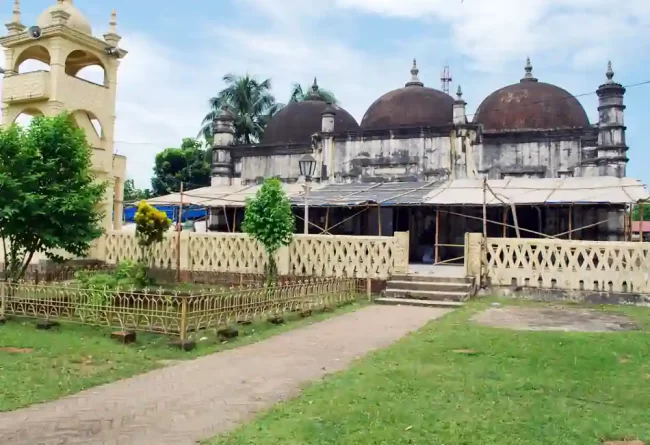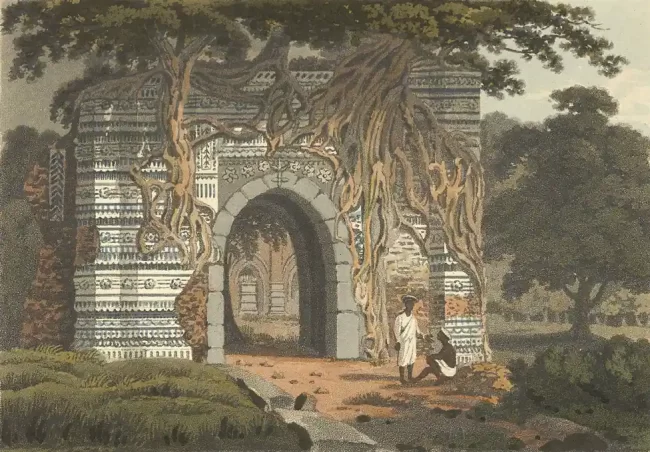Alauddin Husain Shah (Ala-ud-din Husain Shah) was the founder of the Husain Shahi dynasty. His reign (1494-1519) is regarded a brilliant epoch in the history of medieval Bengal.
Early life of Husain Shah
There are several competing narratives and legends about the early life of Alauddin Husain Shah. According to Riyaz-us-Salatin( the first complete history of the Muslim rule in Bengal, written between 1786 and 1788 by Ghulam Husain Salim Zaidpuri), he was the son of one Ashraf Husaini, a sharif (respectable person) of Mecca and an inhabitant of Termez (a town in Uzbekistan). Husain Shah is also known as Sayyid Husain Makki. The expression ‘Sultan Husain Shah bin Saiyid Ashraf-ul-Husaini’ frequently appears on the inscriptions and coins issued during his kingship.
Although it is not known why and how Husain Shah came to Bengal it is claimed by Salim that he stayed in the house of the Qazi of Chandpara, a village in Radha (Rāḍh) where he received his education. The Qazi married his daughter to Husain considering the latter’s noble pedigree.
Alauddin Husain Shah’s rise to power
Husain Shah made inroad to power through his father-in-law who was a Qazi. Beginning from a humble position he eventually became the wazir (chief minister) of Muzaffar Shah, the last Habshi Ruler of Bengal. The latter’s rule was a fitting climax to the infamous Abyssinian epoch in Bengal. He commenced a ruthless destruction of the opposition including noble and learned men of the capital irrespective of their religious adherence. Alauddin Husain Shah brought an end to Muzaffar’s reign of terror and established peace in Bengal.
Terriotiral expansion
Alauddin Husain Shah extended his territory on every side. Referring to the inscriptions found at Bihar’s Saran and Munger, Momtazur Rahman Tarafdar claims that Husain Shahi Bengal included the whole of north Bihar and a part of south Bihar. Husain Shah’s coins, dated between 1494 and 1518, contain the expression ‘conqueror of Kamarupa and Kamta, and Jajnagar and Orissa’.
Alauddin Husain Shah’s military exploits can be grouped under five heads: a) achievements in Bihar, b) war with Kamrarupa and Assam, c) war with Orissa, d) war with Tippera and e) Occupation of Chittagong.
Husain Shah’s achievements in Bihar
In 1495, Delhi’s Sultan Sikandar Ludi defeated the last ruler of the Sharqi Kingdom of Jaunpur. The defeated Sultan Husain Shah took refuge with his namesake Alauddin Husain Shah of Bengal. In response, Sikandar Ludi sent an expedition to Bengal which suffered heavily at the hand of Bengal Sultan’s troops led by his son Daniyal. A peace treaty ensued, and it was decided that both parties would cease to attack each other.
War with Kamrarupa and Assam
Husain Shah led several expeditions against Kamarupa and Kamta between 1494 AD and 1518 AD. This time period is assumed from the fact that the earliest and the latest coins recording the conquest of Kamarupa, Kamta and Orissa are dated 1494 AD and 1518 AD, respectively.
The ruling Khen Dynasty was overthrown and the areas were annexed to the Kingdom of Bengal. Kamarupa was reduced to a tributary status and its rulers, such as Vishva Simha, issue coins in imitation of some Sultani coins.

Husain Shah advanced further eastwards along the upper Brahmaputra valley of Assam. His army comprised infantry and cavalry, according to Mirza Muhammad Kazim’s Alamgirnamah, secured an initial victory over the Assamese troops. He returned to Bengal leaving his son the task of subjugating the region. However, the Assamese King, taking the opportunity of rain, inflicted heavy defeat on the Bengal Sultan’s troops.
War with Orissa
Throughout the reign of Husain Shah, Bengal’s war with Orissa continued, and the numismatic evidences suggest that he simultaneously fought against Orissa and Kamarupa. However, he attained some temporary success only.
War with Tippera
Husain Shah had encounters with the king of Tippera, Dhanya Manikya, and inspite of early reverses succeeded in annexing a part of Tippera to his kingdom.
Occupation of Chittagong by Husain Shah
In the tripartite war that was waged among the rulers of Bengal, Tippera and Arakan over the possession of Chittagong, Husain was also able to occupy Chittagong, which formed an integral part of the Husain Shahi kingdom till 1538.
Towards the end of his reign a Portuguese mission came to Bengal to establish diplomatic links.
Inscriptions of Alauddin Husain Shah
77 inscriptions of Husain Shah have so far been discovered.
The earliest one was found in a dilapidated mosque in village Depara, at a little distance to the northeast of Pandua, West Bengal. It records the construction of a mosque by Majlis al-Majalis Majlis Barbak in the year 1494 AD (899 AH) during the reign of Husain Shah.

Translation:
The Prophet, may the peace and blessings of Allah be upon him, says, “ Whosoever builds a mosque in the world, Allah the Most High shall build (for him) seventy castles in Paradise”. The mosque was constructed in the time of the just and liberal Sultan, descendent of the chief among the Prophets, Husain Shah Sultan, may Allah perpetuate his kingdom. And the builder of this house of benevolence is Majlis al-Majalis Barbak, dated 4th of the month of Jamadi II, 899 A.H. ( March, 1494 A.D.) [ Source: Corpus of the Arabic and Persian Inscriptions of Bengal, edited by Abul Karim, Asiatic Society of Bangladesh, 1992, pp.235-36]
Coins issued by Alauddin Husain Shah
The earliest coins of Husain Shah are all dated 1494 AD.
Conclusion
Husain Shah’s reign ended in 1519 AD with his demise.

Banner photo: Kherur Mosque at Kherur Village, Murshidabad, India. The mosque was built during the reign of Sultan Alauddin Husain Shah.

1 Comment
Erminia
May 9, 2023This site offers an abundance of valuable information on a variety of topics. Thanks for all that you do.